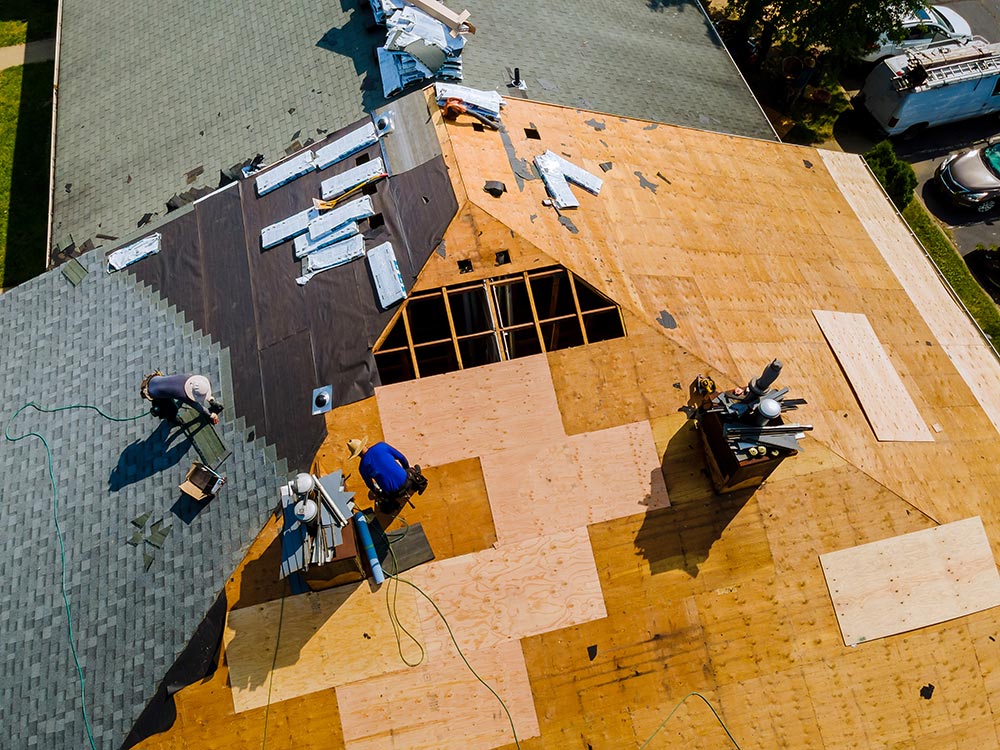Sometimes referred to as “roof sheathing,” your roof deck refers to the thin boards of wood that span across the trusses and support structures of your entire roof. If your roof deck gets wet, it can start to rot (which will affect your roof’s performance). These problems can go unnoticed, because the damaged roof deck is hiding between the shingles and the attic insulation. The roof deck isn’t usually visible, so it can be hard for homeowners to find the problem before it becomes more serious. You just have to know when and how to look for a rotted roof deck.

Why a Rotting Roof Deck Can Be a Problem
If you have a rotting roof deck, it could lead to fungal growth that can ruin its stability by eating away at the wood. But whether there is a fungus or just normal decay, a rotting wood deck can cause several problems for your roof and your home. Some of them include the following:
- Bowing or bulging — Moisture and wood rot can cause your roof deck to sink in or swell up. From the outside, it will look like you have a bulging or bowing spot on your roof. The shingles located above this spot may not work properly. If you let it go for too long, your roof deck can eventually collapse.
- Fungal and mold growth — Wood rot and moisture can lead to mold and fungal growth if it’s left unchecked, which can reduce your home’s air quality and can make the symptoms of certain respiratory conditions worse.
- Damage to insulation — Wood rot and moisture can damage your attic insulation, which is located under your roof deck. This can lower your home’s energy efficiency, which can cause you to spend more money on heating and cooling.
- Wood damage in other parts of your home — Dry wood rot can spread to other parts of your home, including its wooden support structure. Replacing structural wood can be expensive, so you want to stop dry wood rot as soon as you find it.
- Damage to other home systems — If the moisture issue that caused the wood rot isn’t taken care of, it can damage other parts of your home (including the electrical system). Wet rot can also spread to other types of wood if it’s left unchecked.
Be sure to speak to a roofing professional for more information.
How to Identify a Rotting Roof Deck
There are two main types of wood rot: dry rot and wet rot. There are also several subspecies of wood rot fungus, so every infestation may look different. Wet wood rot tends to look discolored or darker than the roof around it. Dry wood rot will often look like normal fungal growth. It also makes the wood look cracked and dry.
Here are some other signs that can help you to identify wood rot in your roof:
- Wood that looks darker in some spots.
- Black, white, yellow, brown, or gray growths and discoloration.
- The wood feels spongy and weak to the touch.
- The wood easily crumbles or cracks.
- The wood has a damp and musty smell.
An experienced roofer may think there could be wood rot by stepping on the shingles above it and can feel it give more than it should, but other signs of wood rot may include:
- Grey, white, or brown growths on the wood (which can look like mushrooms or pizza).
- Wood that has dried out and has long cracks.
If you believe you have a rotting wood deck, be sure to speak to a professional as soon as possible.
When You Should Check Your Deck for Wood Rot
You should have a professional check your roof deck during the following circumstances:
- When you’re about to sell your home and want to make sure your roof will improve its value.
- When you’re purchasing a new home and want to make sure the roof is in good condition.
- When your roof had a leak, tree damage, or any other type of damage.
- When you’re doing a full roof replacement.
- When your attic has experienced moisture issues.
- When you’re about to install a new attic insulation or ventilation.
If a roofer believes that the decking may not be in good condition, he or she may want to take a look at it. But it may be possible to notice the signs of deck damage from inside the attic. If you believe your roof deck has been damaged and are looking for one of the best roofers in Corpus Christi, be sure to get in touch with Bayfront Roofing.